January 8, 2018
A Monthly Newsletter for Paulist Associates
The Associates World is the newsletter of the Paulist Associates. You can download a copy of this newsletter in PDF format (excellent for printing), or scroll down to read it in your Web browser.
- Looking Back Over 60 Years
- Paulist Pilgrimages
- Finding Clarence Walworth
- Save the Date
- Grand Rapids Reflects on Isaac Hecker
- Proposed Program for February
- Prayer for the Intercession of Father Isaac T. Hecker
- Contacts
- Promise
by Fr. Charlie Martin, C.S.P.
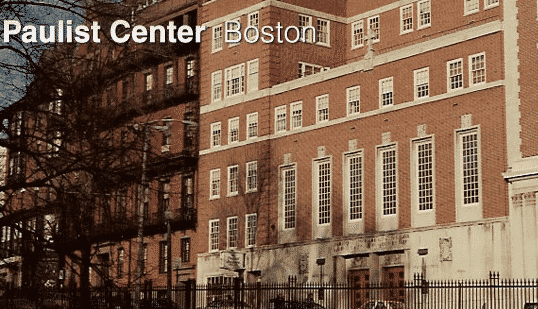
When The Catholic Information Center and Holy Ghost Chapel in Boston opened in their new facility in 1957, George Fitzgerald and I were attending a special school located at the Boston College Intown at 126 Newbury. The school was known as the School of St. Philip Neri for Delayed Vocations. BC Intown was also the location of the BC School of Nursing and the original location for the School of Social Work, the School of Management and various other programs. I had some contacts with Paulist priests when they had spoken at the campus ministry at the University of Massachusetts, Amherst. When I began at St. Philip Neri, I made contact with a couple of them, Fr. Walter Gouch and Fr. Edward Kron; they in turn had put me in touch with Fr. John Kelly, the Vocation Director. I had also introduced George to the Paulists. The upshot of these contacts was that George and I were invited to attend the dedication by Archbishop Richard Cushing of the Center and Chapel. I don’t remember many specifics about that ceremony but it was attended by an overflow crowd which spilled-out onto Park Street which I think was closed for the occasion.
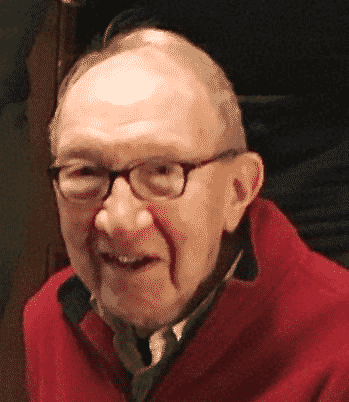
Fr. Charlie Martin, CSP is currently in residence at The Paulist Center in Boston.
He keeps active in senior ministry. For example, he served as the narrator of the recent documentary, Isaac Hecker and the Journey of Catholic America. He is a wonderful contributor at the Associates monthly meeting.
Fr. Charlie is also an avid swimmer and competes in tournaments — and often wins in his age bracket.
After Bishop Richard Cushing became the archbishop in 1944 he invited the Paulist Fathers into the Archdiocese of Boston to establish an Information Center and take responsibility for St Ann’s Parish near Symphony Hall and campus ministry for several college and educational programs in the area. In 1945 the Paulist Father opened The Catholic Information Center at 5 Park Street and this was followed in 1947 by the opening the Chapel of the Holy Ghost at 4 Park Street. The archbishop also arranged for the purchase of the properties on Park Street, three parcels, that would become the future home of both the Information Center and Holy Ghost Chapel. The Archbishop wanted a Catholic presence on Beacon Hill and even though the facility was not located on Beacon Street itself it would certainly be an obvious location in the Beacon Hill neighborhood. Sitting between the offices for Houghton Mifflin Publishing and the Union Club, the new facility, by its location made a statement. On the occasion of the dedication both of the major newspapers — The Boston Globe and The Boston Herald — published special sections with photos and comments on the new facility and the ministry of the Paulist Fathers.
To appreciate the significance of the opening of the Catholic Information Center and Holy Spirit Chapel, it might be well to recalls some of the realities of the time. Dwight Eisenhower was the U.S. President, Foster Furculo was the Governor, and Thomas Hynes was the Mayor. The language of the Catholic liturgy was Latin. The altar in the new chapel faced the wall and of course there was an altar rail where people knelt to receive communion under one form. The pope was Pius XII and he had begun his reign in 1939. Boston was a notably Catholic city and the vast majority of the Catholic population had immigrant roots, Irish, Italian, French, Portuguese, German, etc. Daily Mass was available in several churches and chapels located throughout the city and daily attendance was a common practice for many. In terms of the history and culture of the city, Catholics “had arrived.”
But time does not stand still. Shortly after George and I, along with 18 other men, had begun our novitiate with the Paulists in the Fall of 1958, Pius XII died and another Italian Cardinal, Giuseppe Roncali, who took the name Pope John XXIII, was elected to replace him. Within the first year of his pontificate, John announced that he planned to convene and ecumenical council, and so he did. This same pope also made Archbishop Cushing a cardinal in 1958.
The reason I touch ever so briefly on these pieces of history is to underscore the dynamic that I believe has been the constant challenge for the Paulist Fathers leadership, the pastoral ministers and lay leaders and membership of the Paulist Center community have had to struggle with — constant change — both in the larger society, in the city, and in the Church. By the time George Fitzgerald and I were ordained as Paulist priests in 1965 the Church was in a period of enormous change as a result of the vision of the Vatican Council II. Today the language of the Liturgy is the language of the people. The altar no longer faces the wall, the altar rail is gone, far fewer people consider themselves Catholic, the Paulist Fathers and other religious communities have far fewer members and our political situation presents some distinctly different challenges. But as I look back over 60 years that the Paulists have been in this location, there is still an important role that the ministry of the Paulist Center plays in the city and in the Church: to bring the healing and liberating message of Jesus to all those people among whom we live, and to spend ourselves in the service of others in building the Kingdom of God. It has not been an easy journey for anyone involved, there have been some major bumps along the road but I believe the Holy Spirit or if you prefer, the Holy Ghost, has kept us on the path and headed in the right direction.
The Saints of England
June 3 to 14, 2018
The Loyola Experience
July 6 to 17, 2018
by Fr. Frank Desiderio, C.S.P., Paulist Associates National Director

On a Friday, before picking someone up at the bus station in Albany, I arrived early and made my way to Old St. Mary’s Church in downtown Albany. Fr. Clarence Walworth was pastor of St. Mary’s for 30 years starting in 1866. Here’s a plaque from the outside of the Church.
I said a prayer and moved on.
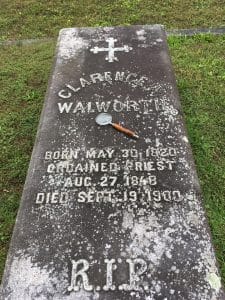
I went through the museum again, to remind myself of the details of this most interesting New York family. This one inscription hints at the heroic and twisted tale of the family of Ruben Hyde Walworth, the last Chancellor of the State of New York, and Sarah Ellen Hardin, a relative of Mary Todd Lincoln.
A short drive brought me to the Greenridge Cemetery. The map at the entrance gave me my bearings.
Some circuitous driving and searching brought me to the final resting place of Fr. Clarence Walworth. I swept his grave clean, said some prayers and took a picture of it with my sleuthing glass.
Here is Fr. Walworth’s necrology, which the Paulists read on the anniversary of his death.
September 19, 1900 Rev. Clarence A. Walworth
Today we pray in thanksgiving for the vocation of Clarence Augustus Walworth and his service to the People of God.
Walworth was born in Plattsburg, New York on May 30, 1820; the eldest son of Reuben Walworth, the last chancellor of the State of New York. He graduated from Union College, Schenectady, in 1830. After a very short career in the law he entered the Protestant Episcopal Theological Seminary in New York City and studied there for three years.
He left the seminary and was received into the Catholic Church in 1845. Soon after he entered the Redemptorist novitiate in Belgium together with Paulist Founder Isaac Thomas Hecker. He was ordained a Catholic priest in Holland on August 27, 1848. Recruited in 1851, along with Fr. Hecker, they formed an English – speaking mission band for the United States. Later Augustine Hewit, George Deshon and Francis Baker joined them on the Redemptorist mission band.
One of the first members of the Paulist Fathers, Walworth’s robust health suffered from the excessive demands of fifteen years on the missions. He left the Paulists in 1858; returned in 1861; but left again in 1865.
One of the most distinguished Catholic preachers of his age, Walworth’s voice was of a medium pitch, clear and musical. His bearing and looks were elegant. As Paulist Walter Elliott wrote, “He was dramatic without being theatrical.”
After leaving the Paulist Fathers, Walworth returned to his home diocese of Albany, NY. In 1866, he became the pastor of St. Mary’s Church in Albany, where he served for more than 30 years.
As a pastor, Walworth waged incessant war against the liquor dealers in Albany, spending many hours before the state legislature, testifying before committees. He was also a great advocate of the cause of Kateri Tekawitha, although he never lived long enough to see her beatified. At the time of his death, in his rectory in Albany, Walworth was 80 years old and 52 years a priest.
Paulist Associates Regional Retreat for 2018 — Chicago
July 13-15, 2018
Details will be made available next month.
Reflection by Rita Loper — Paulist Associate in Grand Rapids – published November 2017
Few great undertakings in the Church have been conceived and carried on to success without the cooperation, in some shape, of women …
(1886, The Church and the Age, p.146; The Paulist Vocation, p.256)
After reading this quote from Fr. Isaac Hecker the first time, I wondered about his use of the words “cooperation of women.” As I looked up the synonyms of “cooperation,” they are: “collaboration, partnership, teamwork.” The quote began to take on more meaning for me. Knowing that Father Hecker was a man of his times but also ahead of his times, he understood the importance of women in the Church. From the very beginnings of the Church women like Mary the Mother of Jesus and Mary of Magdala, were partners in laying the foundation and spreading the “good news” of the gospel.
Other great women also known as saints, have been team players, role models and visionaries in the Church. The writings of Teresa of Avila and Hildegard of Bingen are still relevant today as they were in the Middle Ages. In America, Fr. Hecker would have heard of Elizabeth Seton who lived in New York City and then Baltimore during the early years of our nation. She opened the first free Catholic school for girls which became the start of the parochial schools in the United States and founded the Sisters of Charity, known for their work in teaching and serving the poor. Dorothy Day worked tirelessly for peace and social justice in the 20th century.
Father Hecker spoke the truth about the role of women in the the great undertakings of the Church through the centuries. He would be proud of the many women who continue to play an active role in the Church, especially in North America.
(This is a suggested format; each group may select another outline or topic.)
Fr. Frank DeSiano, C.S.P., the President of Paulist Evangelization Ministries (PEM), recently wrote a thoughtful and thought-invoking piece entitled “The Conversion of America.” The Paulist Associates Board believes that this is an impressive contribution to the dialogue around the Paulist mission for the 21st century.
This is the fourth and final installment, which includes a section of that article along with some questions that Fr. Frank has prepared for us.
Theme: The Conversion of America – Part 4 (last in the series) by Fr. Frank DeSiano, CSP
Opening Prayer: The Paulist Prayer Book, select the day on which you meet
Reading (in advance of the meeting)
There is, however, a final conversion, and maybe that is the first one of all. To talk about the “conversion of America,” as Father Hecker thought of it, was to invite modern people to consider the Catholic faith as a church that could contain the answers to humankind’s deepest longings. While this is undoubtedly true for Catholic believers and missionaries, the particularism of the appeal may seem like proselytizing. Inviting people to think of becoming Catholic might, at least initially, seem just too sectarian for modern people.
But there might be another avenue to pursue. Whatever the attitudes about belonging to the Catholic Church, we have plenty of impetus today to ask people to consider involvement the Kingdom of God as Jesus embodied it.
The Fifth Conversion
The last conversion that we should strive for is to awaken America to the vision of the Kingdom of God, and to urge people to accept this as a framework for both personal and social vision. What does the Kingdom consist in? A realization that all of history is driving forward into a state where every person is loved and accepted for her or himself; a society in which everyone has access to justice; a culture in which care and forgiveness are the first instincts; a realm in which the poor and misplaced have an equal place at the table. That this was the vision of Jesus, and the motive behind his ministry, does not make this a sectarian, partisan goal. Jesus acts out of Jewish prophetic preaching, but his message resonates with every human and can exist in a variety of cultures. How Asians and Africans might espouse the Kingdom, for example, might be quite different than Latin America or the societies of the First World.
In some way, all American political reality has been a yearning for the Kingdom—from the arrival of the Spaniards in Florida, and the French in Canada, and the English in Virginia and Massachusetts; from the expansion along rail-road lines into the Midwest to the settlements of California; from ideals in both the Republican and Democratic parties; from the New Deal to “Let’s Make America Great”—all of this has appealed to an ideal vision which corresponds, one way or another, to the Kingdom of God.
If Americans want to begin with the ideologies of their own political parties, then they still have to show how those ideological starting points—whether individualistic or collective—can grow to encompass the dimensions of the Kingdom of God. Individuals necessarily belong to communities; communities are composed of individuals. But all of us make the same claims on human existence and human community.
When we are living for the Kingdom, perhaps then values will become clearer, and the place of faith and church in the lives of all people will have more cogency. When Fr. Hecker gave his public lectures, he assumed a common soul in his fellow citizens. He assumed, in fact, the dream of the Kingdom, and he gave his life, calling people to faith, to help bring that Kingdom close to fulfillment.
Conclusion
The kind of conversions envisioned here [in these four installments] mostly show how elements of American life, which can theoretically be interpreted in multiple, or even contradictory, ways, can, when interpreted from the perspective of the “pluribus” that we see as our starting, open people to dimensions both of themselves and also of the Kingdom of God. When American reality is interpreted primarily in terms of what each individual derives, for his or her own benefit, from the whole, then the social vectors of this vision tend to veer away from dimensions of the Kingdom. When, on the other hand, American reality is interpreted primarily in terms of the bondedness we have as humans and co-citizens, then the vectors converge more easily on the Kingdom.
To think about moving America closer to the values of the Catholic Church, then, entails moving America closer to prior conversions, almost secular conversions, which allow it to remain faithful to its ideas in a more inclusive way and, at the same time, which dispose it to the richness of the Gospel. Some proto-images of America are clearly religious—the “City on the Hill” of the Pilgrims who wanted to set up an ideal society that could teach all the world. But these proto-images obviously are not enough to bring about the kind of cohesive society that bring about a coherent vision to which missionaries can appeal.
The earliest stories we have of missionaries, in the book of Acts and the letters of St. Paul, show them responding to the deepest self-understanding that societies had of themselves. While missionaries can, and do, appeal to even competing images that Americans have of themselves, how much better our mission field would be if the impulses toward the Kingdom, latent already in American self-understanding, were more coherent and more explicit.
Conversation Catalyst
- What do you make of the idea of the Kingdom of God? How does it speak to you and what does it say?
- In what ways do you think the ideals of America correspond to the ideals of the Kingdom?
- Jesus’ proclamation of the Kingdom earned him radical opposition. Do you think people are more disposed to the values of the Kingdom now than at his time? Why?
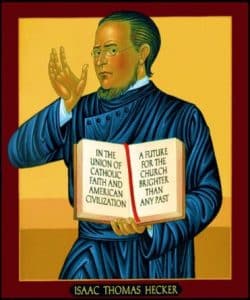
Look upon us this day, with compassion and hope. Hear our prayer. We ask that through the intercession of Father Hecker your servant, you might grant us (state the request).
We ask this in the name of Jesus Christ, Your Son, Our Lord, who lives and reigns with You and the Holy Spirit. One God, forever and ever. Amen.
When you pray this prayer, and if you believe that you have received any favors through Hecker’s intercession, please contact the Office of the Cause for Canonization of Servant of God, Isaac Hecker at [email protected]. Visit the web site: isaachecker.org to learn more about his life and the cause for his canonization.
Paulist Associates National Director
Frank Desiderio, C.S.P.
Paulist General Office
New York, NY 10023
Board Members
Angie Barbieri
Toronto, ON, Canada
Paula Cuozzo
Boston, MA
Cathy Hoekstra
Grand Rapids, MI
Mike Kallock, C.S.P.
Katherine Murphy Mertzlufft
Columbus, OH
Joe Scott, C.S.P.
I believe that I am drawn by the Holy Spirit to the spirituality and qualities of the Paulist Community. I have discerned both by prayer and study that God calls me to become associated with the Paulists. I promise that I will pray for the works of the Paulist Society, meet with others, who are also members of the Paulist Associates, for spiritual sharing and formation; and I seek to embody the apostolic qualities of the Paulists in my daily life.
Attentive to the Holy Spirit and faithful to the example of St. Paul and the charism of Father Isaac Hecker, I commit myself for one year of membership in the Paulist Associates.
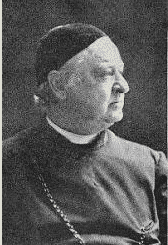 Today we pray in thanksgiving for the vocation of Clarence Augustus Walworth and his service to the People of God.
Today we pray in thanksgiving for the vocation of Clarence Augustus Walworth and his service to the People of God.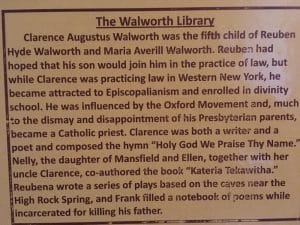 One of the most distinguished Catholic preachers of his age, Walworth’s voice was of a medium pitch, clear and musical. His bearing and looks were elegant. As Paulist Walter Elliott wrote, “He was dramatic without being theatrical.”
One of the most distinguished Catholic preachers of his age, Walworth’s voice was of a medium pitch, clear and musical. His bearing and looks were elegant. As Paulist Walter Elliott wrote, “He was dramatic without being theatrical.”